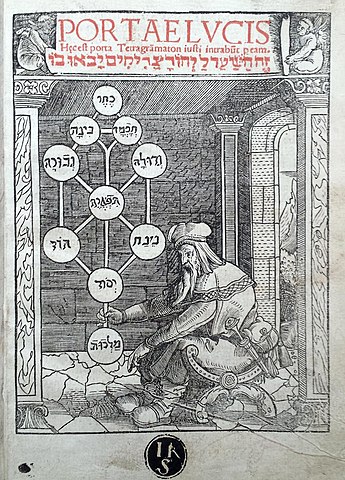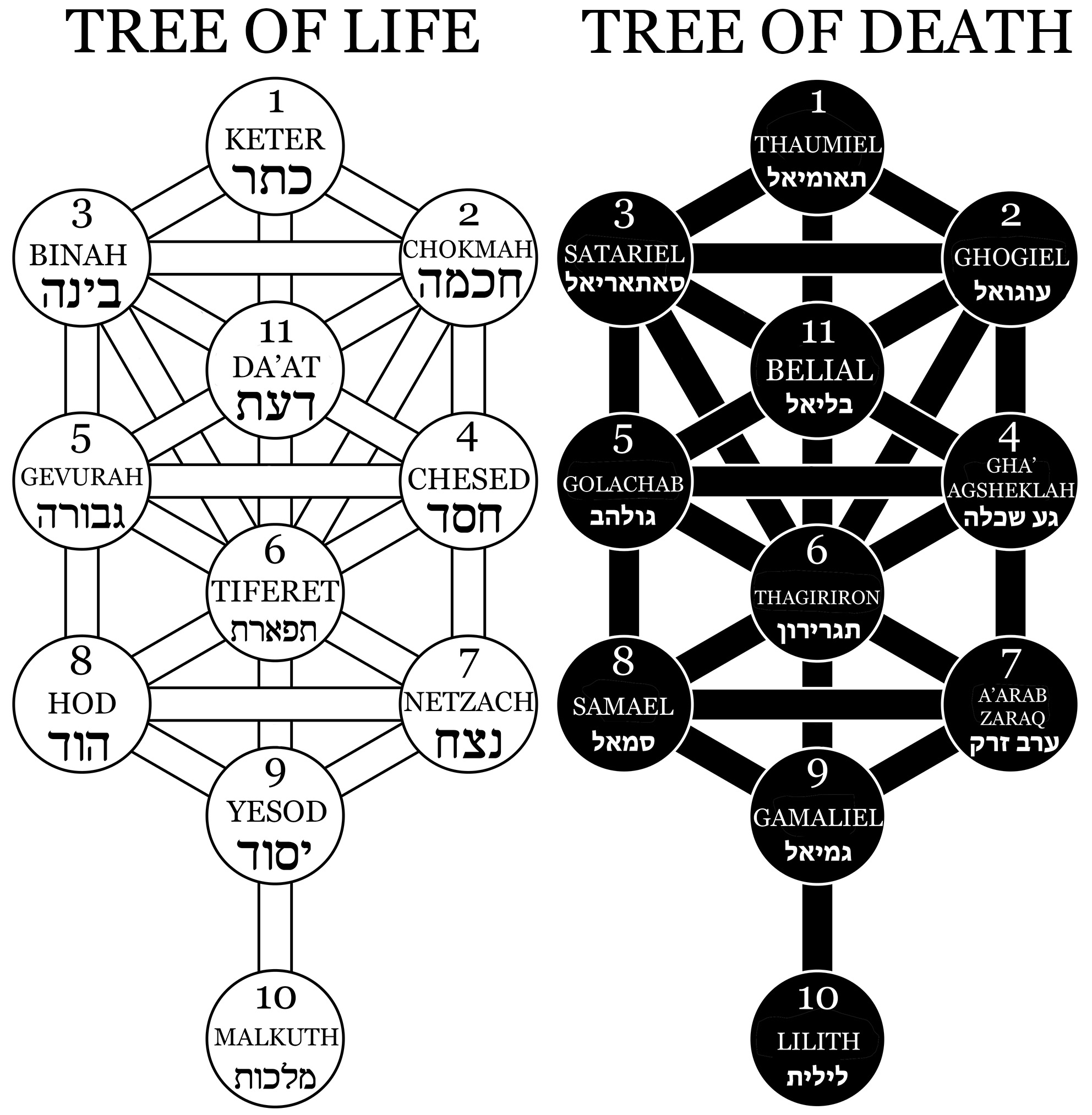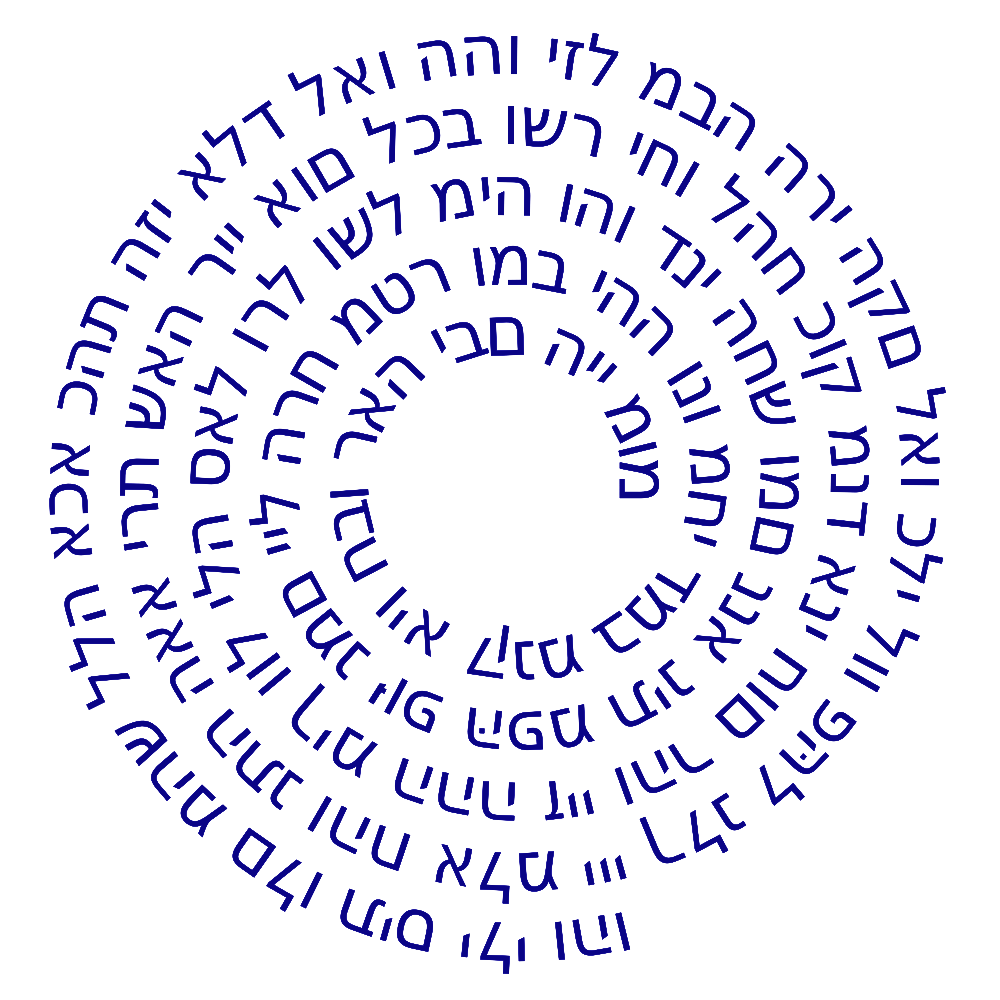Difference between revisions of "Kabbalah"
Occultwiki (talk | contribs) |
Occultwiki (talk | contribs) |
||
| (12 intermediate revisions by the same user not shown) | |||
| Line 1: | Line 1: | ||
[[File: | [[File:Kabbalah Trees Juntos.jpg|400px|thumb|The Tree of Life and Tree of Death side-by-side]] | ||
'''Kabbalah''' (from Hebrew קַבָּלָה (qabalah) | '''Kabbalah''' (from Hebrew קַבָּלָה (qabalah) "reception, accounting") is a Western esoteric tradition involving mysticism and the [[occult]]. It is the underlying philosophy and framework for magical societies such as the [[Hermetic Order of the Golden Dawn|Golden Dawn]], [[Thelema|Thelemic orders]], mystical-religious societies such as the Builders of the Adytum and the Fellowship of the Rosy Cross, and is a precursor to the [[paganism|Neopagan]], [[Wicca]]n and [[New Age]] movements. | ||
The Kabbalah as used by ritual [[magician]]s differs from the [[Judaism|Jewish]] form in being a more admittedly syncretic system, however it shares many concepts with Jewish Kabbalah. | The Kabbalah as used by ritual [[magician]]s differs from the [[Judaism|Jewish]] form in being a more admittedly syncretic system, however it shares many concepts with Jewish Kabbalah. | ||
Non-religious Kabbalistic practices are sometimes called "Hermetic Qabalah," despite having religious overtones. | Non-religious Kabbalistic practices are sometimes called "[[Hermetic]] Qabalah," despite having religious overtones. | ||
==History== | ==History== | ||
Traditionalist Judaic views of Kabbalah's origins view it as an original development from within the Jewish religion, perhaps expressed through syncretic terminology from Medieval Jewish Neoplatonism. Contemporary academics of Jewish mysticism have reassessed Gershom Scholem's theory that the new doctrine of Medieval Kabbalah assimilated an earlier Jewish version of Gnosticism; Moshe Idel instead has posited a historical continuity of development from early Jewish mysticism. | [[File:Portaelucis Cover.jpg|400px|thumb|Cover illustration of ''Portae Lucis'' (1516) showing the [[Tree of Life]] being studied by a Kabbalist.]] | ||
Traditionalist [[Judaism|Judaic]] views of Kabbalah's origins view it as an original development from within the Jewish religion, perhaps expressed through syncretic terminology from Medieval Jewish Neoplatonism. Contemporary academics of Jewish mysticism have reassessed Gershom Scholem's theory that the new doctrine of Medieval Kabbalah assimilated an earlier Jewish version of Gnosticism; Moshe Idel instead has posited a historical continuity of development from early Jewish mysticism. | |||
In contrast, Hermeticists have taken different views of Qabalah's origins. Some authors see the origins of Qabalah not in Semitic/Jewish mysticism or ancient Egyptian [[Gnosticism]], but in a western tradition originating in classical Greece with Indo-European cultural roots, later adopted by Jewish mystics. According to this view, "Hermetic Qabalah" would be the original Qabalah, even though the word itself is Judaic Hebrew, over the Christian Cabalah or the Jewish Kabbalah. | In contrast, Hermeticists have taken different views of Qabalah's origins. Some authors see the origins of Qabalah not in Semitic/Jewish mysticism or ancient Egyptian [[Gnosticism]], but in a western tradition originating in classical Greece with Indo-European cultural roots, later adopted by Jewish mystics. According to this view, "Hermetic Qabalah" would be the original Qabalah, even though the word itself is Judaic Hebrew, over the Christian Cabalah or the Jewish Kabbalah. | ||
| Line 20: | Line 21: | ||
==Mystical revelation== | ==Mystical revelation== | ||
[[File:72 Fold Name of God.png|350px|thumb|The 72-fold name of God]] | |||
When read by later generations of Kabbalists, the Torah's description of the creation in the Book of Genesis reveals mysteries about [[Yahweh|God]] himself. The [[Bible]] provides ample additional material for mythic and mystical speculation. The [[prophet]] Ezekiel's visions in particular attracted much mystical speculation, as did Isaiah's Temple vision. Other mystical events include Jacob's vision of the ladder to [[heaven]], and Moses' encounters with the Burning bush and God on Mount Sinai. | When read by later generations of Kabbalists, the Torah's description of the creation in the Book of Genesis reveals mysteries about [[Yahweh|God]] himself. The [[Bible]] provides ample additional material for mythic and mystical speculation. The [[prophet]] Ezekiel's visions in particular attracted much mystical speculation, as did Isaiah's Temple vision. Other mystical events include Jacob's vision of the ladder to [[heaven]], and Moses' encounters with the Burning bush and God on Mount Sinai. | ||
| Line 32: | Line 34: | ||
==Kabbalah correspondences== | ==Kabbalah correspondences== | ||
<center>''The correspondences in this table are not universally agreed upon by all scholars of Kabbalah.''</center> | Nearly every scholar of the Kabbalah has created their own system of correspondences to link various esoteric concepts into the schema of the sefirot and qlippoth. Unfortunately, correspondences do not always agree with one another and are sometimes in complete opposition, with different authors disagreeing on which color, [[Zodiac]] sign, [[chakra]], or unique gemstone should correspond to a certain sefirot. Given this turbulent history, it becomes exceedingly difficult to create a chart of correspondences which finds approval across all [[ritual magic|magical]] traditions and all authors. | ||
<br> | |||
<center>''The correspondences in this table are not universally agreed upon by all scholars of Kabbalah, they will be updated from time to time.''</center> | |||
{| class="wikitable" style="margin: auto;" | {| class="wikitable" style="margin: auto;" | ||
!colspan="5" style="color:white; background-color:#000000;" |Tree of Life | !colspan="5" style="color:white; background-color:#000000;" |Tree of Life | ||
| Line 84: | Line 87: | ||
| "Kindness" | | "Kindness" | ||
| [[The Emperor]] | | [[The Emperor]] | ||
|style="border-left:solid 2px black |[[ | |style="border-left:solid 2px black |[[Gha’ag Sheklah]] | ||
| "Smiters" | | "Smiters" | ||
| [[Temperance]] | | [[Temperance]] | ||
| Line 171: | Line 174: | ||
[[Category:Kabbalah]] | [[Category:Kabbalah]] | ||
Latest revision as of 22:08, 2 August 2025
Kabbalah (from Hebrew קַבָּלָה (qabalah) "reception, accounting") is a Western esoteric tradition involving mysticism and the occult. It is the underlying philosophy and framework for magical societies such as the Golden Dawn, Thelemic orders, mystical-religious societies such as the Builders of the Adytum and the Fellowship of the Rosy Cross, and is a precursor to the Neopagan, Wiccan and New Age movements.
The Kabbalah as used by ritual magicians differs from the Jewish form in being a more admittedly syncretic system, however it shares many concepts with Jewish Kabbalah.
Non-religious Kabbalistic practices are sometimes called "Hermetic Qabalah," despite having religious overtones.
History

Traditionalist Judaic views of Kabbalah's origins view it as an original development from within the Jewish religion, perhaps expressed through syncretic terminology from Medieval Jewish Neoplatonism. Contemporary academics of Jewish mysticism have reassessed Gershom Scholem's theory that the new doctrine of Medieval Kabbalah assimilated an earlier Jewish version of Gnosticism; Moshe Idel instead has posited a historical continuity of development from early Jewish mysticism.
In contrast, Hermeticists have taken different views of Qabalah's origins. Some authors see the origins of Qabalah not in Semitic/Jewish mysticism or ancient Egyptian Gnosticism, but in a western tradition originating in classical Greece with Indo-European cultural roots, later adopted by Jewish mystics. According to this view, "Hermetic Qabalah" would be the original Qabalah, even though the word itself is Judaic Hebrew, over the Christian Cabalah or the Jewish Kabbalah.
Renaissance magic
Jewish Kabbalah was absorbed into the Hermetic tradition at least as early as the 15th century when Giovanni Pico della Mirandola promoted a syncretic worldview combining Platonism, Neoplatonism, Aristotelianism, Hermeticism and Kabbalah. Heinrich Cornelius Agrippa, a German magician, occult writer, theologian, astrologer, and alchemist, wrote the influential Three Books of Occult Philosophy, incorporating Kabbalah in its theory and practice of Western magic. It contributed strongly to the Renaissance view of ritual magic's relationship with Christianity.
Pico's Hermetic syncretism was further developed by Athanasius Kircher, a Jesuit priest, hermeticist and polymath, who wrote extensively on the subject in 1652, bringing further elements such as Orphism and the Egyptian religion to the mix.
Concept of divinity
A primary concern of Kabbalah is the nature of divinity, its conception of which is quite markedly different from that presented in monotheistic religions; in particular there is not the strict separation between divinity and humankind which is seen in monotheisms. Kabbalah holds to the Neoplatonic conception that the manifest universe, of which material creation is a part, arose as a series of emanations from the godhead.
Mystical revelation
When read by later generations of Kabbalists, the Torah's description of the creation in the Book of Genesis reveals mysteries about God himself. The Bible provides ample additional material for mythic and mystical speculation. The prophet Ezekiel's visions in particular attracted much mystical speculation, as did Isaiah's Temple vision. Other mystical events include Jacob's vision of the ladder to heaven, and Moses' encounters with the Burning bush and God on Mount Sinai.
The 72 letter name of God which is used in Jewish mysticism for meditation purposes is derived from the Hebrew verbal utterance Moses spoke in the presence of an angel, while the Sea of Reeds parted, allowing the Hebrews to escape their approaching attackers. This was subsequently incorporated into ritual magic in the names of the 72 Kabbalistic angels.
Sefirot and qlippoth
The ten sefirot of the Tree of Life are fundamental to understanding the key concepts of Kabbalah. Occultists have syncretized these spheres into virtually everything from astrology to tarot. These forces of divine power are opposed by the qlippoth, which are emanations of the Tree of Death.
Sefirot are the 10 attributes/emanations in Kabbalah, through which Ein Sof ("infinite space") reveals itself and continuously creates both the physical realm and the seder hishtalshelut (the chained descent of the metaphysical Four Worlds). The term is alternatively transliterated into English as sephirot/sephiroth, singular sefira/sephirah. The qlippoth are their shadows, through which previous incarnations of our universe attempt to influence the present world. These "husks" or "shells" may be thought of as mere traces of ancient cosmic energy. Although some magicians of the Left-hand path work with qlippoth, most Kabbalistic magicians view them as harmful and explicitly evil.
As revelations of the creator's will, the sefirot and qlippoth should not be thought of as living deities or literal worlds, but rather as ten different channels through which the one God reveals His will.
Kabbalah correspondences
Nearly every scholar of the Kabbalah has created their own system of correspondences to link various esoteric concepts into the schema of the sefirot and qlippoth. Unfortunately, correspondences do not always agree with one another and are sometimes in complete opposition, with different authors disagreeing on which color, Zodiac sign, chakra, or unique gemstone should correspond to a certain sefirot. Given this turbulent history, it becomes exceedingly difficult to create a chart of correspondences which finds approval across all magical traditions and all authors.
| Tree of Life | Tree of Death | ||||||||
|---|---|---|---|---|---|---|---|---|---|
| Category | Sphere | Sefirot | Meaning | Tarot Card | Qlippoth | Meaning | Tarot Card | Sphere | Category |
| Super-conscious | 1 | Keter | "Crown" | The Magician | Thaumiel | "Twins of God" | Justice | 1 | Realm of Darkness |
| Conscious intellect | 2 | Chokmah | "Wisdom" | The High Priestess | Ghogiel | "The Hinderers" | The Hanged Man | 2 | |
| 3 | Binah | "Understanding" | The Empress | Satariel | "Concealers" | Death | 3 | ||
| Conscious emotions | 4 | Chesed | "Kindness" | The Emperor | Gha’ag Sheklah | "Smiters" | Temperance | 4 | Realm of Evil |
| 5 | Gevurah | "Discipline" | The Hierophant | Golachab | "Burners" | The Devil | 5 | ||
| 6 | Tiferet | "Glory" | The Lovers | Thagiriron | "The Disputers" | The Tower | 6 | ||
| 7 | Netzach | "Victory" | The Chariot | A’arab Zaraq | "Corrosive Ones" | The Star | 7 | ||
| 8 | Hod | "Splendour" | Strength | Samael | "Poison of God" | The Moon | 8 | Realm of Mud and Clay | |
| 9 | Yesod | "Foundation" | The Hermit | Gamaliel | "Obscene Ones" | The Sun | 9 | ||
| 10 | Malkuth | "Kingdom" | Wheel of Fortune | Lilith | "Queen of Night" | Judgement | 10 | ||
| Unification | 11 | Da'at | "Knowledge" | The World | Belial | "Worthless" | The Fool | 11 | Gateway |
Primary texts
Historical texts that form the foundational concepts of Kabbalistic doctrine are:
Sefer HaRazim, was, according to the Kabbalists, transmitted by the angel Raziel to Adam after he was evicted from Eden. Another famous work, the early Sefer Yetzirah, is dated back to the patriarch Abraham. This tendency toward pseudepigraphy has its roots in apocalyptic literature, which claims that esoteric knowledge such as magic, divination and astrology was transmitted to humans in the mythic past by the two angels, Aza and Azazel (in other places, Azaz'el and Uzaz'el) who fell from heaven.
As well as ascribing ancient origins to texts, and reception of Oral Torah transmission, the greatest and most innovative Kabbalists claimed mystical reception of direct personal divine revelations, by heavenly mentors such as Elijah the Prophet, the souls of Talmudic sages, prophetic revelation, soul ascents on high, or Ascended Masters. On this basis, Arthur Green speculates, that while the Zohar was written by a circle of Kabbalists in medieval Spain, they may have believed they were channeling the souls and direct revelations from the earlier mystic circle of Shimon bar Yochai in 2nd century Galilee.

